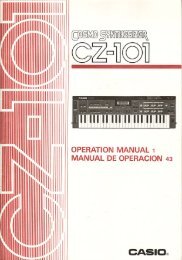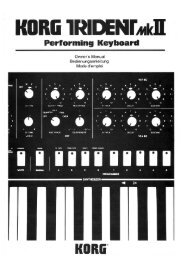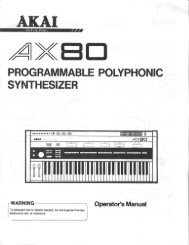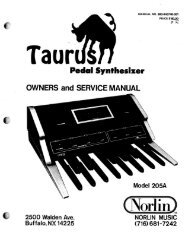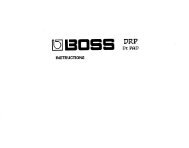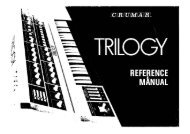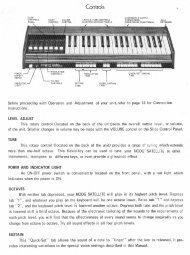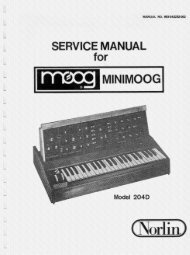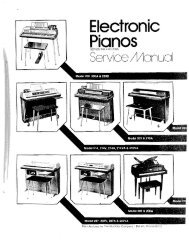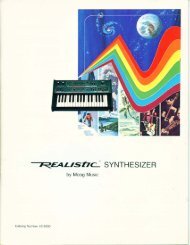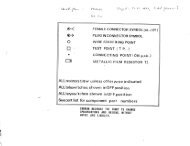Alesis Micron Owners Manual.pdf - Fdiskc
Alesis Micron Owners Manual.pdf - Fdiskc
Alesis Micron Owners Manual.pdf - Fdiskc
You also want an ePaper? Increase the reach of your titles
YUMPU automatically turns print PDFs into web optimized ePapers that Google loves.
22<br />
3 Patterns<br />
2. Send to setup?<br />
Pressing the control knob at this option sends you to [setups]<br />
mode and allows you to make this pattern a part of the lastselected<br />
setup.<br />
If the setup does not have any parts, this pattern is automatically<br />
assigned to the setup’s part A.<br />
If the setup already has one or more parts, you will be able to add<br />
the pattern in one of the following ways:<br />
1. send to part. The setup’s part will use this pattern. Remember<br />
that a part uses both a program and a pattern. If the part’s<br />
program is set to “(pattern’s pgm)”, then the pattern will sound<br />
just as it does in Patterns mode. Otherwise, the setup will play the<br />
pattern using the part’s own program.<br />
2. layer. The setup’s existing part is duplicated, resulting in a new<br />
part. The pattern is then sent to the new part.<br />
3. split low. The setup’s existing part is split in two at a particular<br />
key.<br />
The <strong>Micron</strong> prompts for a note on the keyboard at which to<br />
execute the split. The pattern is then sent to the lower part of the<br />
split. Every note below the one you select will use this new pattern.<br />
Every note including and higher than the note you select will use the<br />
setup’s existing part.<br />
The new part is assigned the next letter after the split part. For<br />
example, if the setup contains parts A, B, C, and D, and part B is<br />
the part that gets split, then part C will be the newly-added part.<br />
All later parts’ letters are incremented by one.<br />
To select the split point, turn the control knob or play a key. You<br />
can use the [octave] buttons if your desired split point is outside<br />
of the current key range.<br />
4. split high. The setup’s existing part is split in two at a<br />
particular key.<br />
As with the split low option, the <strong>Micron</strong> prompts for a note on the<br />
keyboard at which to execute the split. The pattern is then sent to<br />
the upper part of the split. Every note above the one you select will<br />
use this new pattern. Every note including and lower than the note<br />
you select will use the setup’s existing part.<br />
Send to setup only allows the<br />
option of sending the pattern<br />
to the current setup.<br />
Therefore, you may need to<br />
jump out of pattern editing to<br />
choose a setup before<br />
returning to patterns and<br />
following this procedure.<br />
How part letters change<br />
when “layer,” “split low,”<br />
and “split high” are used<br />
When parts are layered or<br />
split high, the new part is<br />
assigned the next letter after<br />
the targeted part. All<br />
subsequent part letters are<br />
incremented by one.<br />
For example, consider a<br />
setup with four existent parts:<br />
A<br />
B<br />
C<br />
D<br />
If we split part B, the result is<br />
as follows:<br />
A<br />
B (low split of B)<br />
C (high split of B)<br />
D (formerly “C”)<br />
E (formerly “D”)



